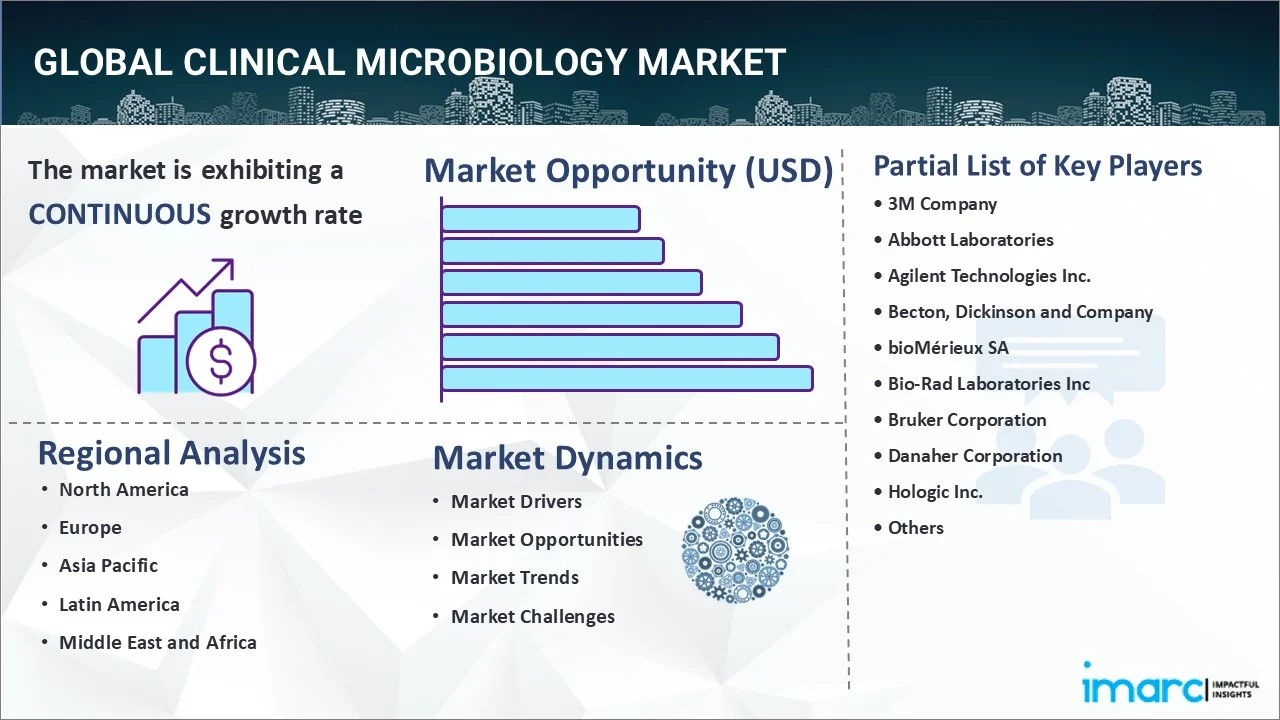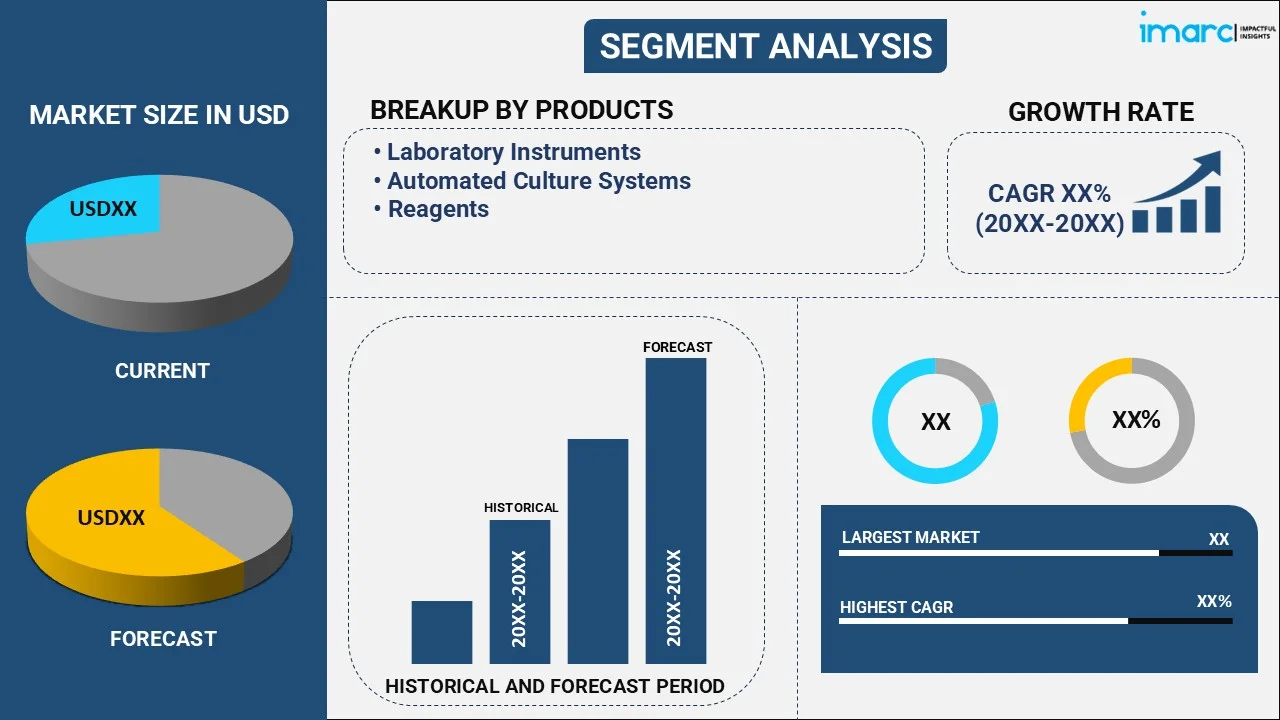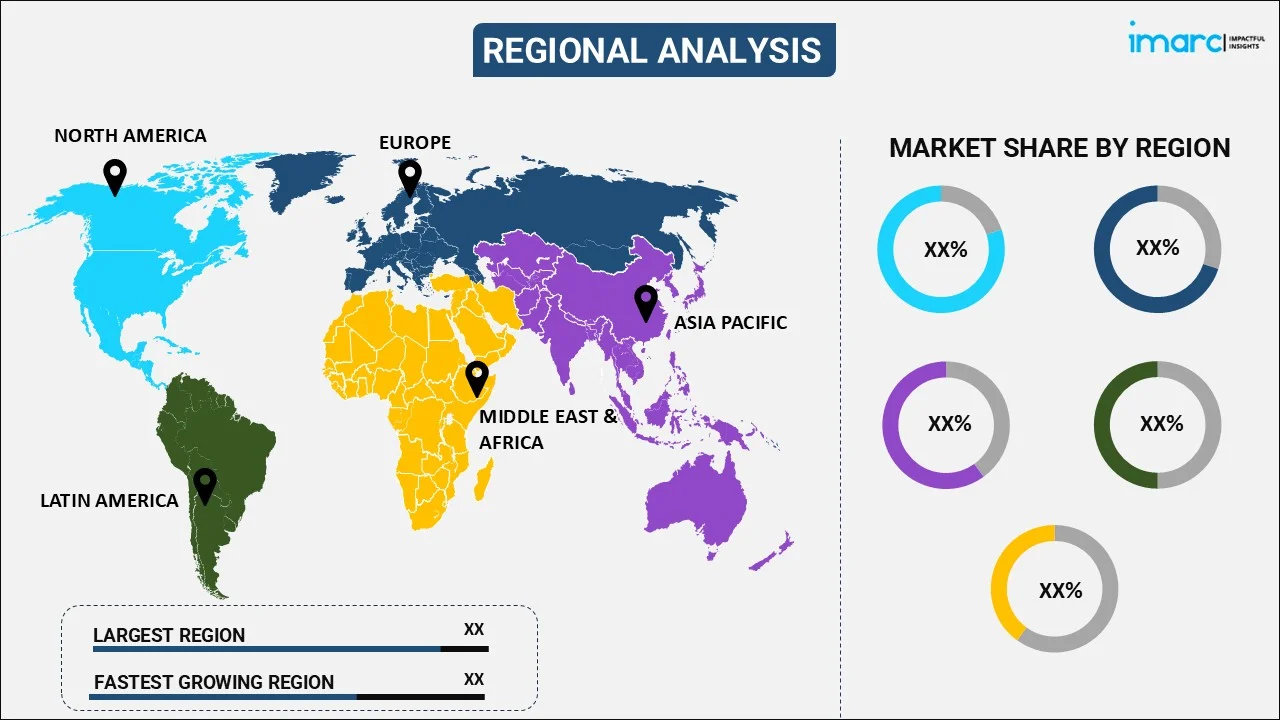
Clinical Microbiology Market Report by Product (Laboratory Instruments, Automated Culture Systems, Reagents), Application (Respiratory Diseases, Bloodstream Infections, Gastrointestinal Diseases, Sexually Transmitted Diseases, Urinary Tract Infections (UTIs), Periodontal Diseases, and Others), End User (Hospitals and Diagnostic Centers, Custom Lab Service Providers, Academic and Research Institutes), and Region 2025-2033
Market Overview:
The global clinical microbiology market size reached USD 4.7 Billion in 2024. Looking forward, IMARC Group expects the market to reach USD 7.7 Billion by 2033, exhibiting a growth rate (CAGR) of 5.39% during 2025-2033.
|
Report Attribute
|
Key Statistics
|
|---|---|
|
Base Year
|
2024
|
|
Forecast Years
|
2025-2033
|
|
Historical Years
|
2019-2024
|
|
Market Size in 2024
|
USD 4.7 Billion |
|
Market Forecast in 2033
|
USD 7.7 Billion |
| Market Growth Rate 2025-2033 | 5.39% |
Clinical microbiology is a field of medical science that assists in diagnosing, preventing, and treating various infectious diseases. It focuses on identifying the presence of bacterial, viral, fungal, or parasitic agents and determining the susceptibility of microorganisms by conducting various tests. Some of the commonly used testing methods are direct smears and stains, cultures, molecular analysis, serological testing, and antibiotic susceptibility testing. Presently, clinical microbiology is gaining traction across the globe on account of its effective antibiotic administration and improved treatment outcomes.

Clinical Microbiology Market Trends:
The increasing prevalence of infectious diseases around the world represents one of the primary factors propelling the growth of the market. Additionally, the rising air and water pollution levels are increasing incidences of respiratory diseases among individuals, which, in turn, is driving the market. Apart from this, the integration of automation in clinical microbiology is creating a favorable outlook for market growth as it enables specimen traceability, eliminates delays in incubations and improves the efficiency of laboratory operations. Furthermore, the leading players are focusing on introducing technological advancements in disease diagnostics, such as the adoption of machine learning (ML), which aids in providing quick and accurate results. This, along with the introduction of several molecular diagnostic techniques, is offering lucrative growth opportunities to the market. Moreover, the rising adoption of advanced clinical diagnostic techniques, including real-time polymerase chain reaction (PCR), next-generation sequencing (NGS), and mass spectrometry for effective identification and characterization of pathogens, is acting as another growth-inducing factor. Other major factors, including the increasing number of new microorganisms causing various infectious diseases and the burgeoning healthcare sector across the globe, are anticipated to impel the growth of the market.
Key Market Segmentation:
IMARC Group provides an analysis of the key trends in each sub-segment of the global clinical microbiology market report, along with forecasts at the global, regional and country level from 2025-2033. Our report has categorized the market based on product, application and end user.
Breakup by Product:

- Laboratory Instruments
- Incubators
- Gram Stainers
- Bacterial Colony Counters
- Autoclave Sterilizers
- Petri Dish Fillers
- Automated Culture Systems
- Microbiology Analyzers
- Molecular Diagnostic Instruments
- Microscopes
- Mass Spectrometers
- Reagents
Breakup by Application:
- Respiratory Diseases
- Bloodstream Infections
- Gastrointestinal Diseases
- Sexually Transmitted Diseases
- Urinary Tract Infections (UTIs)
- Periodontal Diseases
- Others
Breakup by End User:
- Hospitals and Diagnostic Centers
- Custom Lab Service Providers
- Academic and Research Institutes
Breakup by Region:

- North America
- United States
- Canada
- Asia-Pacific
- China
- Japan
- India
- South Korea
- Australia
- Indonesia
- Others
- Europe
- Germany
- France
- United Kingdom
- Italy
- Spain
- Russia
- Others
- Latin America
- Brazil
- Mexico
- Others
- Middle East and Africa
Competitive Landscape:
The competitive landscape of the industry has also been examined along with the profiles of the key players being 3M Company, Abbott Laboratories, Agilent Technologies Inc., Becton Dickinson and Company, bioMérieux SA, Bio-Rad Laboratories Inc, Bruker Corporation, Danaher Corporation, Hologic Inc., Merck KGaA, QIAGEN N.V and Thermo Fisher Scientific Inc.
Report Coverage:
| Report Features | Details |
|---|---|
| Base Year of the Analysis | 2024 |
| Historical Period | 2019-2024 |
| Forecast Period | 2025-2033 |
| Units | Billion USD |
| Segment Coverage | Product, Application, End User, Region |
| Region Covered | Asia Pacific, Europe, North America, Latin America, Middle East and Africa |
| Countries Covered | United States, Canada, Germany, France, United Kingdom, Italy, Spain, Russia, China, Japan, India, South Korea, Australia, Indonesia, Brazil, Mexico |
| Companies Covered | 3M Company, Abbott Laboratories, Agilent Technologies Inc., Becton Dickinson and Company, bioMérieux SA, Bio-Rad Laboratories Inc, Bruker Corporation, Danaher Corporation, Hologic Inc., Merck KGaA, QIAGEN N.V and Thermo Fisher Scientific Inc. |
| Customization Scope | 10% Free Customization |
| Post-Sale Analyst Support | 10-12 Weeks |
| Delivery Format | PDF and Excel through Email (We can also provide the editable version of the report in PPT/Word format on special request) |
Key Questions Answered in This Report
The global clinical microbiology market was valued at USD 4.7 Billion in 2024.
We expect the global clinical microbiology market to exhibit a CAGR of 5.39% during 2025-2033.
The sudden outbreak of the COVID-19 pandemic has led to the increasing adoption of clinical microbiology for testing fungal infections as a side-effect of the coronavirus infection.
The rising prevalence of infectious diseases, owing to the increasing air and water pollution levels, along with the adoption of Machine Learning (ML) in disease diagnostics for providing quick and accurate results, is primarily driving the global clinical microbiology market.
Based on the product, the global clinical microbiology market can be segmented into laboratory instruments, automated culture systems, and reagents. Currently, laboratory instruments hold the majority of the total market share.
Based on the application, the global clinical microbiology market has been divided into respiratory diseases, bloodstream infections, gastrointestinal diseases, sexually transmitted diseases, Urinary Tract Infections (UTIs), periodontal diseases, and others. Among these, respiratory diseases currently exhibit a clear dominance in the market.
Based on the end user, the global clinical microbiology market can be categorized into hospitals and diagnostic centers, custom lab service providers, and academic and research institutes. Currently, hospitals and diagnostic centers account for the largest market share.
On a regional level, the market has been classified into North America, Asia-Pacific, Europe, Latin America, and Middle East and Africa, where North America currently dominates the global market.
Some of the major players in the global clinical microbiology market include 3M Company, Abbott Laboratories, Agilent Technologies Inc., Becton Dickinson and Company, bioMérieux SA, Bio-Rad Laboratories Inc, Bruker Corporation, Danaher Corporation, Hologic Inc., Merck KGaA, QIAGEN N.V, and Thermo Fisher Scientific Inc.
Need more help?
- Speak to our experienced analysts for insights on the current market scenarios.
- Include additional segments and countries to customize the report as per your requirement.
- Gain an unparalleled competitive advantage in your domain by understanding how to utilize the report and positively impacting your operations and revenue.
- For further assistance, please connect with our analysts.
 Inquire Before Buying
Inquire Before Buying
 Speak to an Analyst
Speak to an Analyst
 Request Brochure
Request Brochure
 Request Customization
Request Customization




.webp)




.webp)












